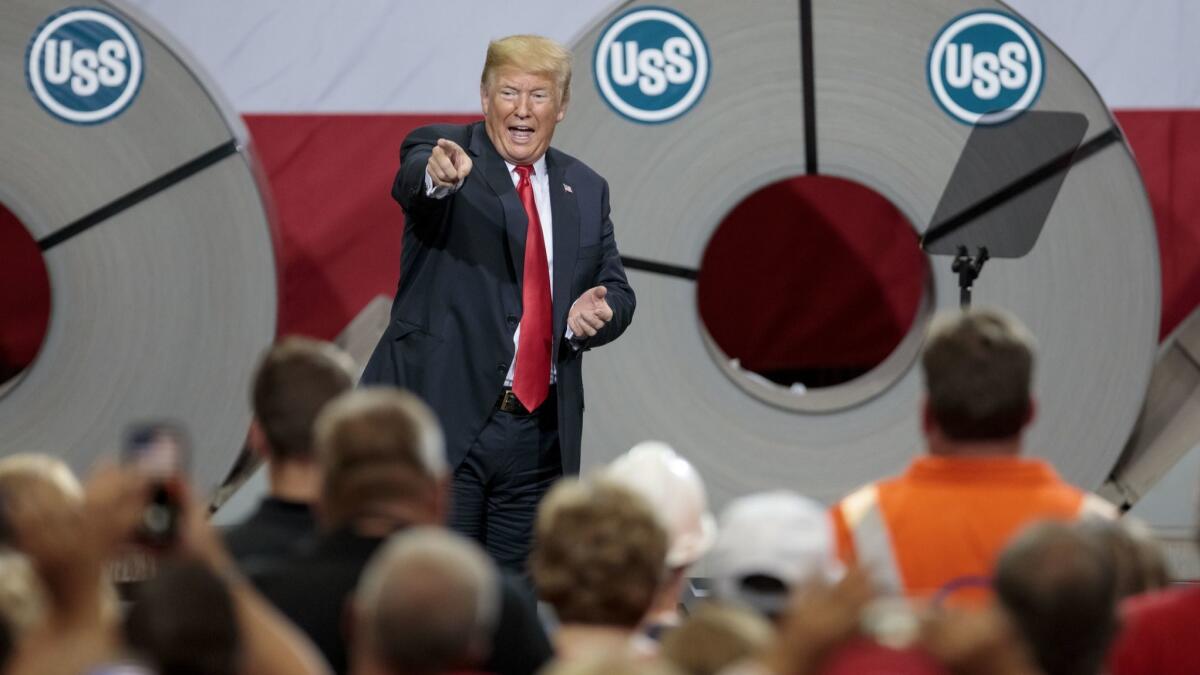Trump celebrates his tariff policies with Illinois steelworkers amid complaints from Midwest farmers

- Share via
Reporting from Washington — A day after announcing a truce in a brewing trade war with Europe, President Trump returned to his protectionist script during two stops across the Midwest on Thursday, touting the reopening of an Illinois steel mill as proof that his tariffs are helping workers.
Despite opposition from the region’s farmers hurt by other nations’ retaliatory tariffs on agricultural products — and from the farmers’ Republican representatives in Congress — Trump urged patience first in Iowa, then in southern Illinois, and asserted that the healthy economy made this an opportune time to pick a fight on trade.
“This is the time to straighten out the worst trade deals ever made by any country in the history of earth. But now they’re becoming good again,” Trump told steelworkers at a United States Steel Corp. mill in Granite City, Ill.
He has reached no deals during his presidency, however, instead turning to tariffs against trading partners in recent months. Explaining his hard-line stance to the steelworkers, Trump said America had been “the big dumb piggy bank and everyone was robbing us blind.”
“We lost our businesses and our jobs to other countries,” he said. But now, Trump said, “We’re fighting back and we’re winning.”
Trump’s event captured the unpredictable swings that have marked his trade policy. The celebration of the reopening of two blast furnaces, which the steel company attributed to Trump’s 25% tariffs on imported steel, came a day after the president held a Rose Garden ceremony with the European Commission president to announce a trade truce, including his concession to reconsider his steel and aluminum tariffs.
Trade policy is again shaping up as a significant political issue heading into November’s midterm election. Yet it seems to hinge on the mood swings of a president who’s long been skeptical of the free trade principles that used to unite his party, and is willing to exercise executive authority in a protectionist way that recent predecessors rarely have.
Essential Washington: Here’s our look at the Trump administration »
Yet Trump now is confronting the predicted downsides of tariffs. Months after he targeted steel and aluminum imports and placed tariffs on $34 billion in Chinese goods, trading partners’ retaliatory tariffs targeting U.S. agricultural products are threatening farmers, businesses and blue-collar workers in states that Trump won in 2016.
An NBC News/Wall Street Journal poll this week showed that most voters — by a 2-to-1 margin — believe the tariffs will be harmful to the economy.
Trump’s Rose Garden news conference Wednesday seemed to be an effort to lower the rhetorical temperature on trade and allay American anxieties about additional economic fallout. And it marked another instance of the president claiming credit for having resolved a crisis mostly of his own making, when he simply was returning to the status quo and much work and negotiations lay ahead.
In Iowa, which along with Illinois is the nation’s top soybean producer and bears the brunt of retaliatory tariffs, Trump spoke in glowing terms about the initial agreement with the European Union. He and European Commission President Jean-Claude Juncker agreed to start negotiations toward a U.S.- EU trade deal and avoid new tariffs in the meantime.
“Basically, we opened up Europe,” the president said, exaggerating during a roundtable with political and business leaders in Peosta, an eastern Iowa town outside Dubuque. “You’re not going to be too angry with Trump, I can tell you.”
Seemingly trying to dissolve the anxiety among agricultural producers by declaring the situation fixed, Trump spoke of a bond between himself and the pork, corn and soybean producers, who are now increasingly unnerved by the prospect of retaliatory tariffs from other countries.
“The farmers love me. They voted for me. We won every one of the states,” Trump said. He blamed other countries for imposing the retaliatory agricultural tariffs, saying, “It’s not nice, what they’re doing.”
With a green-and-yellow “Make our farmers great again” ball cap near him on a table, Trump said he’d convinced Juncker to get EU countries to buy more soybeans from American farmers.
The EU had already been importing soybeans and liquid natural gas. Juncker’s promise to push European countries to import more of both was presented as a concession, in exchange for Trump dialing back his threats of more tariffs, including on European autos, while both sides work toward a permanent trade deal.
Analysts had viewed Trump’s more amiable tone on trade Wednesday as a tactical move to address mounting criticism in his own party. In quickly reverting to his populist message of economic nationalism, the president left little doubt about his true sentiments.
Coming just a day after Trump talked like a free trader, extolling the ideas of zero tariffs and zero trade barriers, his attacks on existing trade deals and trading relationships threw cold water on the notion that he wanted anything less than outright concessions from other countries.
Not many Europeans were holding out high hopes to begin with, said Fredrik Erixon, an economist and director of the European Center for International Political Economy, a think tank in Brussels. On Thursday, European leaders were debating whether Juncker’s approach to Trump was too soft. The French government signaled its disappointment and preference for playing hardball with Trump.
Erixon reckoned that the temporary truce would buy Europe a little more time, but he wasn’t optimistic that the talks with Trump would amount to much.
“There was a sigh of relief after the meeting yesterday,” he said. “Now there’s a big question mark: How on earth do you go from here into the future?”
Trump’s Midwestern swing was mostly about easing worries and taking credit. At the steel plant, across the Mississippi River from St. Louis, Trump said that “to see an old, big monster plant like this reopening, that is an honor.”
Underscoring that he sees groups like the steelworkers as his political base, Trump, the New York real estate mogul born to wealth, then told them, “I could be one of you. True. Looking around, all these good-looking people, it could be me.”
Earlier, on the flight to Iowa, Commerce Secretary Wilbur Ross told reporters that the president’s hard-line stance on trade had brought the EU to the negotiating table.
“If we hadn’t had steel and aluminum tariffs, we never would have gotten to the point we are now,” Ross said aboard Air Force One. “This is a real vindication of the president’s trade policy.”
That statement, however, was misleading at best. Before Trump took office, the U.S. and EU had been in tough but advanced trade negotiations after years of talks; his election, and general hostility to trade deals, effectively ended the effort.
Ross said that the U.S. had not lifted the tariffs Trump imposed but had agreed to hold off on automotive tariffs while negotiations take place: “In terms of auto tariffs, we’ve been directed by the president to continue the investigation, get our material together, but not actually implement anything pending the outcome of the negotiation.”
He said the report on auto tariffs would be submitted in August. Imposing them “may not be necessary,” Ross said, but he added that in the meantime, “steel and aluminum tariffs stay in place.”
Even so, Juncker said in the Rose Garden, with Trump beside him, that the president had agreed to reconsider those tariffs.
In more contradictory statements on trade this week, the president tweeted Tuesday morning that “Tariffs are the greatest!” Then, standing beside Juncker on Wednesday afternoon, he called for “zero tariffs” at some point.
Times staff writer Don Lee contributed to this report.
More to Read
Get the L.A. Times Politics newsletter
Deeply reported insights into legislation, politics and policy from Sacramento, Washington and beyond. In your inbox twice per week.
You may occasionally receive promotional content from the Los Angeles Times.










